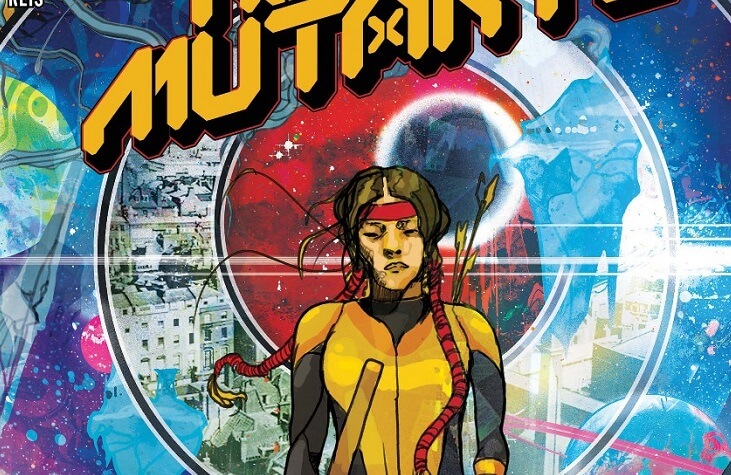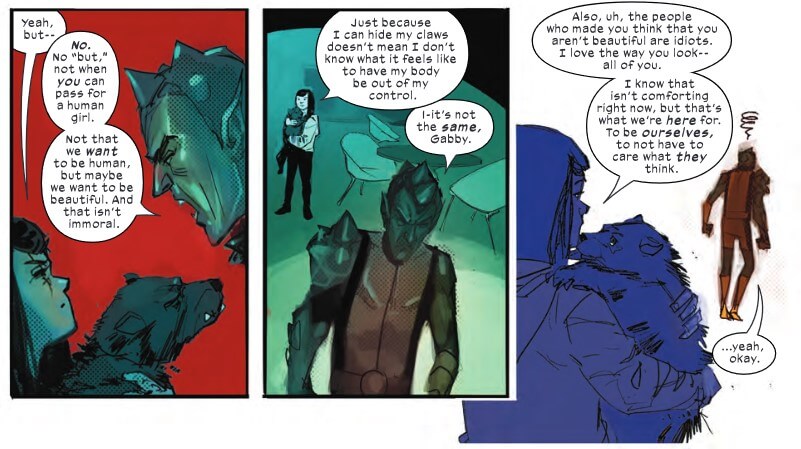New Mutants #17 continues to try to shed light on the anxieties and issues hidden in the new world of Krakoa, following Rahne, Dani and Xi’an, and the young mutants under the Shadow King’s tutelage in plot lines that are slowly beginning to intertwine. The month-long gap between #16 and #17 makes this issue feel especially stuffed full of intrigue and characters — but it also makes at least one storyline feel rushed and insubstantial.
New Mutants #17
Vita Ayala (writer), VC’s Travis Lanham (letterer), Tom Muller (design), Rod Reis (artist),
Marvel
April 26, 2021
This issue opens with a sickly yellow page, reinforcing the hopeless despair Rahne is feeling upon learning that her child might not be dead after all, though his whereabouts are completely unknown to her. She’s almost catatonic, consumed with what her own imagination can conjure. Rod Reis paints her eyes as black circles, popping open in wary surprise when Farouk arrives at ALPHA House to recruit her into his current plan.
The Shadow King walks right into that yellow light, sidling into her vortex of emotional pain, and extends a hand. Rahne is suspicious — and she should be! But he plays her easily. He needs her to help children, after all, and she has a desperate need to be needed. Reis emphasizes the size difference between the hulking Farouk and the petite, wolfen Rahne, her round eyes shining as she gazes up at him, almost childlike herself. It’s a striking contrast to the happy and carefree Rahne of the earlier issues.
Karma and Moonstar pick up a freelance gig with Meryln in exchange for their freedom (and lives). The McGuffin of the issue is a vessel stolen by Lady Roma (it looks like the sassy little sugar pot from Sword in the Stone, very appreciated). Lady Roma gets in some flirtation, which is nice, and Reis’ depiction of Otherworld battles is bathed in sunlight and intense bright pops of reds and pinks. The women pick up a magic item, too, all in exchange for a favor at a later date, promising even more Otherworld adventures in the future.
But while the side-trip into Otherworld gave Reis an opportunity to really flex and create some beautiful art, I’m not sure it told a complete or satisfying tale about Dani, Karma, or even Josh, the blue teen with horns they were meant to be rescuing before being captured by Merlyn and diverted yet again.
Josh, if you remember, is a transplant from Ayala’s Age of X-Man title, introduced in Earth-616 while getting into some should-be harmless trouble with two of his friends, tempting fate by crossing into Otherworld. He has a crew, is what I’m saying, kids he’s close enough to to flout the rules with, and who are worried about him to the extent that they even ‘fess up to get him help.
When Xi’an and Dani finally track him down this issue, it turns out he’s perfectly fine on his own. In fact, they find him ready to hang up his Krakoan citizenship with nary a “tell my friends I’ll miss them.” It’s an abrupt conclusion and raises multiple practical concerns. Like, doesn’t he want his clothes or toiletries or anything from home? Are the New Mutants allowed to let unaccompanied minors wander off the Island? I think the story of a mutant who chafes at the elevation of mutant-dom on Krakoa (making it into something “special” rather than another normal) would be a fascinating layer to the current world building, but it’s only introduced, not delved into. There’s no deep probing to what’s motivating Josh — is he simply falling into the same trap as his hypocritical liberal parents and longing for assimilation? Or has he found his physical appearance, which resembles a horned demon, too alienating even on Krakoa but totally normal in Otherworld? We see him chatting with another blue-skinned, pointy-eared being; maybe he’s hoping to totally change his identity in a place where he can pass. They’re all plausible with the information we’re given here, but I don’t think the ambiguity is of much value in a book with limited pages and a big cast.
Instead of exploring Josh’s desire for normalcy, balance, or his view that Krakoa is pushing “things too far in the other direction, going hard at being special,” it’s just a fleeting idea, a few pages of Josh spilling his guts out in a very “telling, not showing” way. The mood created with the dark blues and pinks here, alone with Josh becoming a sketchy outline as he talks of his parents’ rejections, just feels more somber than what we’re actually hearing from Josh, or the way Dani and Xi’an ultimately resolve the situation.
The whole thing me feel uneasy and I suspect it’s supposed to — I’ve been buoyed along just like these X-characters on the hope of what Krakoa represents, a better world for the marginalized, and here are stark reminders that not everyone is as dazzled by the promise of eternal life, and not everyone feels a deep kinship with the rest of the mutant community, regardless of humanity’s interference. But New Mutants wants to remind me of how utopia isn’t here yet.
One of my favorite parts of New Mutants is the way the younger generation is far more direct and political than their (still young) elders. They push back against platitudes like “you ARE beautiful,” instead cutting to the very political heart of acceptance and aesthetics. It’s very well and good for the conventionally attractive and very human looking older New Mutants to learn to love the skin they’re in, when that skin isn’t green or blue or asymmetrical.
Anole underscores this feeling of being different even on an island populated with mutants. He also explicitly mentions “passing” as human when yelling at Gabi. Even among mutants, there are body politics to be hashed out. However, Anole and Josh are both interesting choices to deliver the message — while they have green and blue skin, they’re also very symmetrical and have slim, muscled bodies. Normative bodies in a superhero book, even. The most non-normative bodies we see in this book are again Farouk, for his size, and Cosma, for her non-symmetry. I desperately want this book to explore what the politics of desire ARE for the world of Krakoa, and how Anole fits outside of that.
All three segments in New Mutants #17 focus on the limitations of Krakoa. Simply being surrounded by other mutants isn’t the instant balm of acceptance that many mutants would like it to be. The generational divide, too, is stark. It’s hinted that they’re forgetting the past in embracing the Shadow King, but they also reject the attitudes and priories of their elders as well. Krakoa allows them to focus on broader desires and needs than simply survival, like fulfillment, beauty, and wholeness. The conflict here, the way they scrape against each other as a community, is fascinating — I just wish I was able to linger on it longer.



